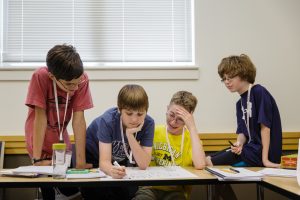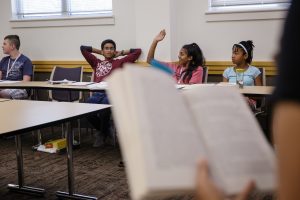This is part four in a series of blog posts written by some of our undergraduate students doing P4C in local pre-college classrooms. Read the introduction by Dr. Claire Katz here.
Nicole:
Recently several classmates and I had the opportunity to practice philosophy with children in the classroom. We worked with seventh and eighth graders in their own environment. The experience was amazing and more rewarding than I could have ever imagined. Although we had been discussing for weeks what it is or could be like to implement this kind of study and teaching in school systems, it was certainly a much different experience to implement what we learned rather than than just talk about it.
We were given the chance to visit Harmony Academy several times this semester. We had a different philosophical activity for each visit: The Ship of Theseus, Ring of Gyges, the prisoner’s dilemma and a reality scavenger hunt.
 We began all our lessons in a large group to introduce the subject we would be discussing that day and then would break up into small groups with fewer than ten students in each group. On our first day to work with the eighth graders, not surprisingly, many of our young students were not too sure about philosophy and were slightly confused by what exactly philosophy is. There were many blank stares and looks across the room at each other to see if others were just as confused as them. We discussed the Ship of Theseus, and once we broke into small groups I noticed that some of the kids became more alert than they had in the larger group. My group began our discussion by taking a vote on who thought the Ship of Theseus was the same, different, or both the same and different ship. Then we went around the circle and everybody gave a reason why they believed what they did. Most of my students answered with some variation on “because it is” or “because it has to be.” The kids were having a hard time getting past the surface level.
We began all our lessons in a large group to introduce the subject we would be discussing that day and then would break up into small groups with fewer than ten students in each group. On our first day to work with the eighth graders, not surprisingly, many of our young students were not too sure about philosophy and were slightly confused by what exactly philosophy is. There were many blank stares and looks across the room at each other to see if others were just as confused as them. We discussed the Ship of Theseus, and once we broke into small groups I noticed that some of the kids became more alert than they had in the larger group. My group began our discussion by taking a vote on who thought the Ship of Theseus was the same, different, or both the same and different ship. Then we went around the circle and everybody gave a reason why they believed what they did. Most of my students answered with some variation on “because it is” or “because it has to be.” The kids were having a hard time getting past the surface level.
Once we went around the circle one student asked me what the right answer was. That was when it occurred to me the students were expecting to hear they were wrong or right. So my group took a couple minutes to talk about a philosophical discussion and discuss that a “right answer” has to do with the quality of their argument. I confessed to them that even I didn’t have the right answer. After this brief interlude, they seemed to open up a lot more. I see them going more in depth with their answers, using examples in their lives that they thought related to the Ship of Theseus. One girl then came up with the argument that seemed to convince the whole group that the answer was it was both the same ship and a different ship. She compared the situation of the Ship of Theseus to a person receiving a new iPhone. To paraphrase her argument she claimed that when we receive a new iPhone it is a new different phone. She said the phone is new plain and simple, but when we back-up our phones and put out information into our new phone then it is our phone again. Just because it is a new phone on the outside all our information inside is the same as our old phone. The new phone has now become our own phone.
I had to take a minute to process what she had said. It wasn’t at all what I was expecting. All of sudden all the students in our group began talking to each other, using this one girl’s observation as the inspiration. Another student brought up prosthetics and transplants. It was amazing to see all these light bulbs go off in the students’ heads.
The Spaceship of Theseus was one of my favorite discussions we had with both the eighth and seventh graders. I felt it really made the students think about their own lives. Both eighth and seventh graders brought up transplants and prosthetics in our discussions; I was very impressed and excited about the arguments the students came up with.
Our discussions of the Prisoner’s dilemma and the Ring of Gyges were two of my least favorites. We didn’t read the true story of the prisoner’s dilemma, but we introduced the lesson and led them to a similar argument by giving them the chance to win candy. The small groups each of us took put students back to back and gave them a chance to either betray their classmates or share the candy. While back to back, if both students put their thumbs up then both students received two pieces of candy. If both students put their thumbs down then each received one piece of candy. Then if one student had their thumb up and the other down, the student with their thumb down received three pieces of candy and the other student received none.
There was a combination of outcomes in my group when I did it with both seventh and eighth graders. I asked the students afterwards why they made their choices, with the eighth graders most of the answers I received were I don’t know or I went with my first instinct. I got similar answers from the seventh graders, but I also got severals “I just wanted candy.”
This discussion about the prisoner’s dilemma and Ring of Gyges were very surface level in my opinion. In the discussions about ethics I felt the eighth grade group of students thought there was obviously a right answer they were supposed to give because that’s what they’ve always been taught. Majority of the students answers were very black and white. They claimed that if it’s wrong then it shouldn’t be done. That even if they can’t be seen they would do nothing wrong.
In the seventh grader group, some students did claim they would “sneak into the teacher’s lounge” or “take  some extra snacks.” The seventh graders seemed to be a lot more open to accepting the to the thought of the world being something other than black and white. The seventh grade group was much more willing in conversations and they seemed to want to speak more and share opinions.
some extra snacks.” The seventh graders seemed to be a lot more open to accepting the to the thought of the world being something other than black and white. The seventh grade group was much more willing in conversations and they seemed to want to speak more and share opinions.
Our last day with the eighth graders we did a reality scavenger hunt. I believe this was the best day, discussion wise, with the eighth graders. We had a sheet of seventeen questions questioning reality and what different people and all people saw as real or unreal. I think since this day was more centered around what they wanted to talk about and their ideas it gained their attention and made them want to speak.
All in all I truly value this experience. The teachers of Harmony Academy let us know that when the students returned to their own classrooms they continued talking about our lessons. There was a clear difference between the first and last day we had a discussion with both grades. Even if we didn’t get everyone interested in philosophy, we definitely opened their eyes to a new way of thinking.